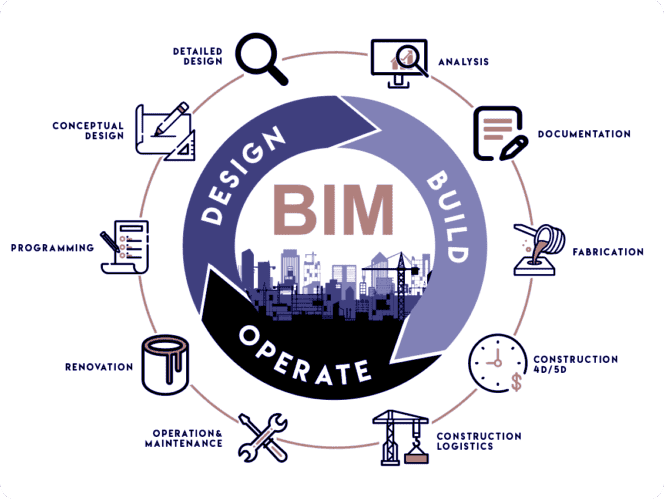
BIM in Architecture Services
In the ever-evolving realm of architecture, technological advancements have become pivotal in reshaping the way professionals approach design and construction. Building Information Modeling (BIM) has emerged as a game-changer, revolutionizing the architectural landscape.
Understanding BIM in Architecture Design Services:
Building Information Modeling (BIM) is a sophisticated and collaborative process that utilizes a digital representation of the physical and functional characteristics of a building. Unlike traditional 2D drawings, BIM provides a three-dimensional, information-rich model that encapsulates every aspect of a structure, from its geometry to spatial relationships, materials, and even cost data.
BIM in architecture design services encompasses a holistic approach, involving architects, engineers, contractors, and other stakeholders. This collaborative platform facilitates seamless communication and coordination throughout the entire lifecycle of a construction project, from conceptualization to maintenance.
Enhanced Collaboration and Communication:
One of the primary advantages of Architecture Design Services in BIM is the improvement in collaboration and communication among stakeholders. Traditional design methods often led to misinterpretations and communication gaps, resulting in costly errors during construction. BIM, however, promotes real-time collaboration, allowing architects, engineers, and contractors to work concurrently on the same model.
This synchronized approach fosters better communication, minimizing the likelihood of discrepancies and reducing the need for costly revisions. Architects can share their designs with engineers, who can then analyze the structural implications in real time. This collaborative workflow ensures that the final design is not only aesthetically pleasing but also structurally sound and economically viable.
Comprehensive Design Visualization:
BIM technology offers a comprehensive and immersive visualization experience that goes beyond the capabilities of traditional design methods. Architects can create detailed 3D models that provide clients and stakeholders with a realistic preview of the proposed structure. This aids in better decision-making, as clients can visualize the end result more effectively, leading to a more informed and satisfied clientele.
Moreover, BIM allows for virtual walkthroughs, enabling stakeholders to explore the building's interiors and exteriors before construction begins. This not only enhances the design review process but also serves as a valuable tool for marketing and presentations.
Efficient Project Management:
Architecture Design Services in BIM streamline project management by integrating all relevant data into a single, centralized model. This unified platform allows for better control over project timelines, costs, and resources. Project managers can track progress, identify potential issues, and make informed decisions based on real-time data.
BIM's ability to simulate the construction process virtually enables professionals to identify and address clashes or conflicts in the early stages of design. This proactive approach minimizes delays and rework during the construction phase, ultimately saving both time and money.
Sustainability Integration:
As sustainability becomes a central focus in modern architecture, BIM proves to be an invaluable tool in incorporating green design principles. Architecture Design Services in BIM allow architects to analyze the environmental impact of their designs, optimizing energy efficiency and resource utilization.
BIM's data-rich models enable architects to simulate different scenarios and assess the environmental performance of a building. This includes analyzing sunlight exposure, ventilation, and overall energy consumption. By integrating sustainability considerations from the early design stages, architects can create buildings that are not only aesthetically pleasing but also environmentally responsible.
Cost Estimation and Analysis:
BIM provides architects with a powerful tool for accurate cost estimation and analysis. The detailed information embedded in the digital model allows for precise quantity takeoffs and cost calculations. This helps in creating more realistic budgets and reducing the likelihood of cost overruns during construction.
Furthermore, architects can perform cost-benefit analyses for different design options, allowing clients to make informed decisions based on financial considerations. This transparency in cost estimation fosters trust between architects and clients, leading to smoother project collaborations.
Regulatory Compliance and Documentation:
Navigating the complex landscape of building regulations and codes is a critical aspect of architectural design. BIM streamlines the process by incorporating regulatory requirements directly into the digital model. This ensures that the design is compliant with local building codes and regulations from the outset.
In addition, Architecture Design Services in BIM generate comprehensive documentation automatically. From construction drawings to material specifications, BIM creates a detailed record of every aspect of the design. This not only simplifies the approval process but also serves as a valuable resource for future renovations, maintenance, and compliance audits.
Future-Proofing Architecture:
The rapid pace of technological advancement requires architects to embrace tools that can future-proof their designs. Architecture Design Services in BIM provide a platform that supports ongoing updates and modifications throughout a building's lifecycle. This adaptability is crucial in an era where design trends, materials, and technologies are in a constant state of evolution.
BIM allows architects to incorporate new information, materials, or technologies seamlessly into existing models. This flexibility ensures that buildings remain relevant and efficient, even as the industry continues to evolve.
Conclusion
Architecture Design Services in BIM have become a cornerstone in the contemporary architectural landscape. The collaborative, data-driven, and comprehensive nature of BIM not only enhances the design process but also addresses the challenges faced by architects in the modern era.
From improved collaboration and communication to sustainable design integration and efficient project management, BIM offers a myriad of benefits that position it as an indispensable tool for architects. As the industry continues to embrace technological innovation, Architecture Design Services in BIM stand out as a transformative force, reshaping the way architects conceive, communicate, and construct the buildings of tomorrow. Embracing BIM is not just a choice; it's a necessity for architects aspiring to thrive in the dynamic and competitive world of modern architecture.

